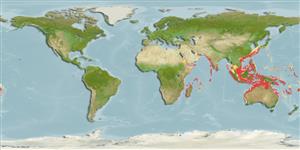Classification / Names
Common names from other countries
Main reference
Size / Weight / Age
Max length : 13.0 cm TL male/unsexed; (Ref. 9824)
Environment
Marine; demersal; depth range 18 - 141 m (Ref. 4900)
Climate / Range
Tropical, preferred ?
Distribution
Indo-West Pacific: Persian Gulf and Red Sea, through the northern Indian Ocean to the South China Sea, north to southern Japan and south to the Indo-Australian Archipelago and New Caledonia. Report from Madagascar needs confirmation.
Countries | FAO areas | Ecosystems | Occurrences | Introductions
Short description
Dorsal
soft rays
(total): 83-98;
Anal
soft rays: 65 - 77;
Vertebrae: 41 - 42. Body with a large dark spot posteriorly on the base of both the dorsal and anal fins and with elongated anterior rays in the dorsal fin.
IUCN Red List Status (Ref. 115185)
Threat to humans
Harmless
Human uses
Fisheries: minor commercial
More information
ReferencesAquacultureAquaculture profileStrainsGeneticsAllele frequenciesHeritabilityDiseasesProcessingMass conversion
Tools
Special reports
Download XML
Internet sources
Estimates of some properties based on models
Phylogenetic diversity index
PD50 = 0.5000 many relatives (e.g. carps) 0.5 - 2.0 few relatives (e.g. lungfishes)
Trophic Level
3.5 ±0.37 se; Based on food items.
Resilience
High, minimum population doubling time less than 15 months (Preliminary K or Fecundity.)
Vulnerability
Low to moderate vulnerability (27 of 100)
Price category
